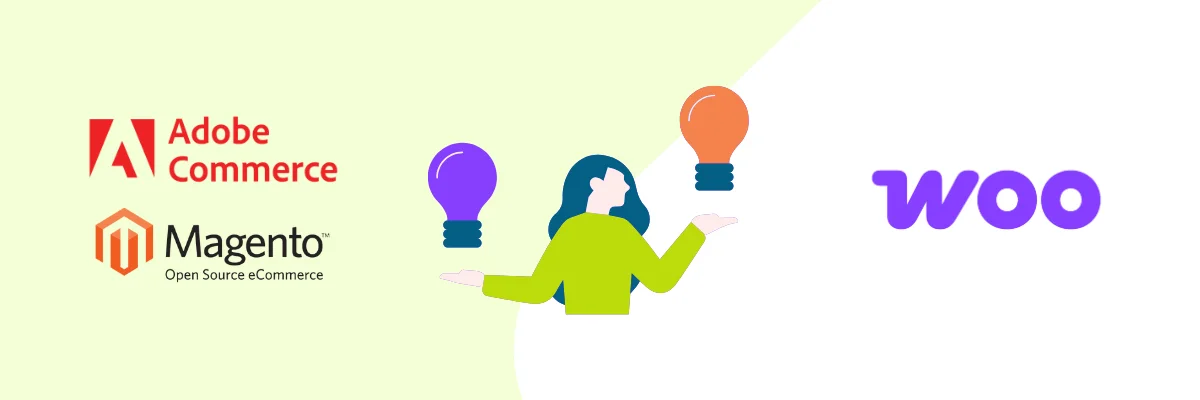

Magento / Adobe Commerce vs WooCommerce: which e-commerce solution best fits your business case?
Published by Rianne Sels
4' reading time
WooCommerce and Magento are among the most widely used e-commerce platforms in the world. WooCommerce is especially popular thanks to its easy integration with WordPress, while Magento (in the variants Magento Open Source and Adobe Commerce) stands out for its power, scalability, and extensive set of built-in features.
For many companies, the journey starts with WooCommerce, but as the webshop grows, switching to Magento can be a logical next step. In this article, we compare both platforms and provide clear guidance to help you determine which solution best fits your business case.
WooCommerce: simple and accessible for small to medium-sized online stores
Getting started easily
WooCommerce is a WordPress plugin that lets you launch your online store in no time, even with minimal technical knowledge. With thousands of plugins and themes available, you can easily extend its functionality and tailor your shop to your needs.
A strong fit for smaller shops
WooCommerce is ideal for:
- Starting entrepreneurs with a limited budget
- Smaller online stores with a modest product range
- Businesses already running on WordPress that want to expand their site with e-commerce functionality, when it fits their business case
Known limitations of WooCommerce when scaling
Although WooCommerce is flexible, it comes with clear limitations:
- Scalability: with larger product catalogs or higher traffic, performance can become a major challenge. This often translates into slower load times, higher bounce rates, and ultimately revenue loss. On top of that, delivering a consistent customer experience becomes harder, which negatively impacts both SEO rankings and customer satisfaction.
- Complex functionality: for B2B features such as quotes, customer-specific pricing, or multi-store setups, separate plugins are usually required. The common issue here is that an overload of plugins can lead to compatibility issues, higher maintenance costs, and increased security risks. It also creates dependency on external developers, which can undermine the stability and future-readiness of your online store.
- Integrations: while WooCommerce offers countless plugins for ERP, CRM, or marketing tool integrations, they are often developed by third parties with varying quality and support. This can quickly lead to compatibility issues and a lack of deep synchronization. For companies that rely heavily on stable integrations with their internal systems, this can cause inefficiency, higher maintenance costs, or even data loss.
- International ambitions: launching multi-store or multilingual setups in WooCommerce can be cumbersome. Often, this requires multiple plugins or even separate WordPress installations, making management complex and error-prone. Synchronizing products, prices, and stock across different languages and countries becomes less efficient and increases the risk of inconsistencies. Centralized reporting and analysis of international sales also become more difficult, slowing down growth and professionalization.
At this point, it’s worth considering Magento Open Source or Adobe Commerce. Especially if your online store is at a tipping point - whether that’s rapid growth, international ambitions, or the need for advanced B2B features. Both Magento variants provide a more stable and future-proof foundation than WooCommerce, with greater control, scalability, and integrated features designed for professional and complex e-commerce environments.
Magento Open Source: free, powerful, and scalable
Robust foundation
Magento Open Source is the free variant of Magento and already offers far more functionality out-of-the-box than WooCommerce. Think product management, order flows, multi-store capabilities, and extensive marketing options.
Particularly ideal for:
- Medium-sized companies that are growing and need more stability
- Online stores with a broader product range or higher traffic
- Businesses that, alongside the extensive set of standard features, also need custom development to support their unique processes and customer experiences
- Companies that want to reduce their dependency on separate plugins
- Organizations that require advanced integrations with ERP, CRM, PIM, or marketing automation systems to streamline processes and centralize data
Adobe Commerce: enterprise e-commerce with powerful B2B tools
An all-in-one solution
Adobe Commerce (the paid enterprise version of Magento) builds on the foundation of Magento Open Source. It offers extensive B2B functionality out-of-the-box, such as:
- Custom price lists per customer group
- Quote management
- Separate catalogs per customer segment
- Bulk ordering and repeat purchases
Scalability and support
In addition, Adobe Commerce provides enterprise-grade support, stronger scalability, and integrations with other Adobe products.
Ideal for:
- Medium to large enterprises with complex e-commerce processes
- (B2B) companies with custom development needs
- International organizations managing multiple stores from a central back office
- Businesses looking for a hosted Adobe solution with guaranteed scalability, security, and enterprise support



Did you know Hyvä is a true gamechanger for Magento / Adobe Commerce?
Hyvä combines a modern front end with an optimized checkout, making both Magento Open Source and Adobe Commerce lightning-fast and highly user-friendly. The result: better performance, higher SEO scores, and increased conversions.
For businesses, this means a scalable and future-proof online store, while developers benefit from a simplified framework that makes custom development faster and more cost-efficient. As a recognized Adobe technology partner, Hyvä continues to roll out new innovations. More to come!
Cost comparison: WooCommerce vs Magento vs Adobe Commerce
- WooCommerce: free plugin, but additional costs for hosting, themes, and plugins. Budget-friendly at first, but expenses rise quickly as you grow.
- Magento Open Source: free software, but with higher hosting requirements and development costs. A solid balance between price and scalability.
- Adobe Commerce: license fees starting from tens of thousands of euros per year, but in return you get a cloud-based solution with extensive B2B modules and full enterprise support.
Conclusion: which choice is the right one?
The choice between WooCommerce, Magento Open Source, and Adobe Commerce largely depends on the size of your online store, your growth ambitions, and your strategic business case.
- WooCommerce is ideal for smaller B2C online stores that want to get started quickly and on a budget. Thanks to its close integration with WordPress, it’s easy to set up, but the platform quickly runs into limitations when it comes to scalability, integrations, and advanced functionality.
- Magento Open Source is the right fit for companies ready to take the next step toward professionalization. The platform is powerful, scalable, and combines a broad set of standard features with the flexibility of custom development. Combined with Hyvä, it delivers a fast, user-friendly, and modern experience. This makes it an excellent choice for businesses that are growing, need stability, advanced integrations, and more control than WooCommerce can offer.
- Adobe Commerce is the go-to B2B e-commerce platform for medium to large enterprises with complex e-commerce processes, international ambitions, and a clear B2B focus—often alongside B2C. With powerful B2B modules, advanced personalization options, and deep integration capabilities, it forms a future-proof foundation for growth. The Cloud variant of Adobe Commerce, fully hosted by Adobe, ensures guaranteed scalability, maximum security, and professional enterprise support. This makes Adobe Commerce the ideal choice for companies seeking absolute reliability and the flexibility of custom solutions.
In summary: if you’re starting small and want to launch quickly, WooCommerce is a great fit. If you’re ready to grow and handle more complexity, Magento Open Source is the logical next step. And for enterprises operating internationally and at scale, Adobe Commerce is in many cases the most future-proof solution.



Ready to make the right choice?
Are you facing a strategic choice around your e-commerce platform, or working on a business case where scalability, B2B functionality, or advanced integrations are key? Our experts in Magento Open Source and Adobe Commerce are happy to think along with you. We’ll help you with a clear platform check and tailored advice, so you can make the right decision for the future of your online store.
👉 Schedule a free consultation and discover which solution will best support the future of your webshop.
Useful links
Looking for extra information or want to dive deeper into the topics covered in this blog? We’ve gathered some useful links where you can find more insights!
- Read more on Magento Open Source
- Read more on Adobe Commerce
- Read the blog: why switch from Magento Open Source to Adobe Commerce?
- Read the blog: The difference between Magento Open Source and Adobe Commerce?
- Discover what we achieved for Bel&Bo: a revamped Magento webshop for Bel&Bo